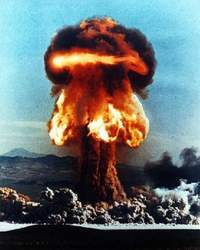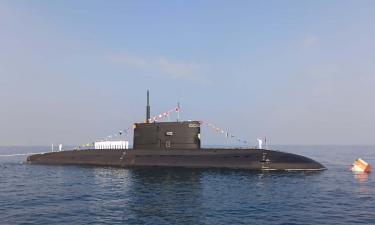Is it possible to make an A-bomb at home?
There are seven members at the international nuclear club at the moment i.e. the United States, Russia, Britain, France, China, Pakistan and India. By all appearances, Israel has a nuclear capability. However, Knesset refuses to confirm it (without denying it, though).

Iran is believed to be a few steps away from building its own atomic bomb. An A-bomb built by the Tehran regime will create a very dangerous situation for the international community. The same applies to North Korea’s nuclear ambitions.
Still, a nuclear weapon in the hands of terrorists will pose the biggest threat to the world. Theoretically speaking, is it possible to build an atomic bomb at home?
The United States was the first country to build and use the atomic bomb. The implementation of Manhattan Project involved the best U.S physicists joining forces with the best scientists who fled Europe during the WW II. Such renowned scientists as Fermi, Feinman, Oppenheimer took part in the project. The world’s richest nation spent enormous financial and material resources on producing the first nuclear weapon. The beast was then unleashed. The Soviet Union tested its A-bomb in 1949, the British tested theirs in 1952, and the Chinese built their own with the help of the Soviets in 1964. India tested the bomb in 1998, and Pakistan successfully tested it two week later.
However, all the above countries built and tested the “vintage” nuclear charges, which are pretty bulky, the size of a wardrobe. Terrorists dream of a more compact bomb, something that can be carried around in a briefcase. A portable nuclear bomb would be a terrorist’s weapon of choice. A terrorist organization with a bomb like that could blackmail the authorities and make some idiotic demands like an immediate introduction of the law of shari‘ah all over the world etc. Alternatively, terrorists could demand a ransom of a billion dollars.
Fortunately, building a small-sized nuclear bomb is impossible at the moment due to a number of physical aspects e.g. the amount of a critical mass of plutonium or uranium-235; specifics of additional mechanisms for bringing together pieces of plutonium in a synchronized manner. However, terrorists might find a way to resolve the problems, and therefore the nuclear powers should take steps to ensure security of their nuclear arsenals. Terrorists just can not produce a “home-made” fission material.
Producing a certain amount of explosive i.e. plutonium or uranium-235 is a critical stage in the development of an atomic bomb. Plutonium is a by-product of the energy release during a nuclear reaction (that is why building nuclear power plants in politically unstable countries is always a matter of concern). Production of uranium-235 requires the splitting ofnaturalisotopes oftheelement, a procedure is carried out most effectively by centrifuges. Iran has recently started up those centrifuges…
It is worthy of notice that the atomic weapon ceased to be a secret a long time ago. Making an A-bomb by some “private enterprise” is now a matter of time and money. Despite being devastated by WW II, the Soviet Union managed to build the bomb virtually as fast as the U.S. did . The Soviet atomic project was fulfilled pretty quickly mostly because the Soviet spies were efficient and therefore the Soviet scientists did not have to use a trial-and-error method. Even in a war-torn Nazi Germany the scientists were just a step away from setting a nuclear reactor in motion i.e. two steps away from making the bomb. On the optimistic side, countries do behave in a more “restrained” manner after joining the nuclear club. For example, India-Pakistan relations definitely improved following their membership in the club.
Below is an excerpt from the letter by Albert Einstein to the U.S. President Franklin Roosevelt, dated August 2, 1939.
“Sir, a bomb of the type will obliterate an entire port and its vicinity if carried by a vessel and detonated in a port. Such bombs could be too heavy to be used for air raids…”
The first atomic bomb was dropped on Hiroshima by an ordinary U.S. Air Force B-29 bomber six years later, on August 6, 1945.
Another excerpt is taken from the letter penned in the trenches by G. N. Flerov, who joined the Soviet army during the WW II. He would be a prominent nuclear scientist in years to come. The letter was written during the summer of 1942. It was addressed to Josef Stalin, Chairman of the State Committee of Defense.
“Dear Josef Vissarionovich, nobody has ever made a point of saying that an atomic bomb could not be built. However, some people are trying to create an impression that the project belongs to the world of science fiction…”
The Special Committee headed by Lavrenty Beria was set up on August 20, 1945. The first Soviet atomic device RDS-1 was tested at a range near the city of Semipalatinsk in Kazakhstan on August 29, 1949.
The so-called “dirty bomb” remains one of the most dangerous versions of the bomb in a “briefcase.” Terrorists just have to steal a radioactive material from a hospital or a flaw detection unit of some industrial company, put it in bag containing half a kilo of TNT and a detonator. Then the bomb is blown up by a remote control. Hundreds of casualties will guarantee excellent publicity for the terrorists. Therefore, cobalt-60 (in ampoules) should be kept under lock and key while most serious security arrangements are in place.
Izvestia Nauki
Translated by Guerman Grachev
Discuss this article on Pravda.Ru English Forum
Subscribe to Pravda.Ru Telegram channel, Facebook, RSS!




